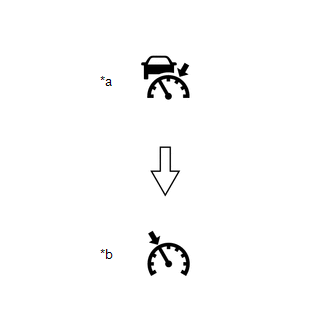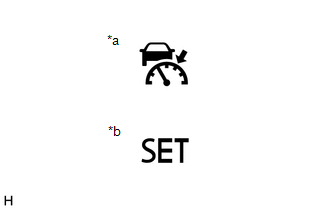Toyota Camry (XV70): Road Test
ROAD TEST
HINT:
- The dynamic radar cruise control system has 2 cruise control modes: constant speed control mode and vehicle-to-vehicle distance control mode.
- Vehicle-to-vehicle distance control mode is selected by default when the dynamic radar cruise control system is turned on using the cruise control main switch.
PROBLEM SYMPTOM CONFIRMATION (CONSTANT SPEED CONTROL MODE)
(a) Inspect the SET function.
(1) Push and hold the cruise control main switch for 1.5 seconds or more with the dynamic radar cruise control system off to change to constant speed control mode.
(2) Check that the cruise control indicator (vehicle-to-vehicle distance control mode) turns off and the cruise control indicator (constant speed control mode) illuminates.

|
*a | Cruise Control Indicator (Vehicle-to-vehicle Distance Control Mode) |
|
*b | Cruise Control Indicator (Constant Speed Control Mode) |
(3) Drive at a speed between approximately 30 km/h (20 mph) and 200 km/h (125 mph).
(4) Push the -SET switch.
(5) Check that the cruise SET indicator illuminates at this time.

|
*a | Cruise SET Indicator |
(6) After releasing the switch, check that the vehicle maintains the set vehicle speed.
HINT:
If the vehicle speed decreases to 16 km/h (10 mph) less than the set vehicle speed such as when driving on a steep slope, control of vehicle speed by the constant speed control mode is canceled.
(b) Inspect the + (ACCEL) function.
(1) Push and hold the cruise control main switch for 1.5 seconds or more with the dynamic radar cruise control system off to change to constant speed control mode.
(2) Drive at a speed between approximately 30 km/h (20 mph) and 200 km/h (125 mph).
(3) Push the -SET switch.
(4) Check that vehicle speed increases while the +RES switch is pushed, and that the vehicle maintains the newly set vehicle speed when the switch is released.
(5) Push the +RES switch and then release it immediately. Check that vehicle speed increases by approximately 1 km/h (1 mph) (tap-up control).
HINT:
If the difference between the set vehicle speed and actual vehicle speed is 5 km/h (3 mph) or more, tap-up control will not operate.
(6) Confirm that the set vehicle speed displayed on the multi-information display changes when the +RES switch is pushed.
(c) Inspect the - (COAST) function.
(1) Push and hold the cruise control main switch for 1.5 seconds or more with the dynamic radar cruise control system off to change to constant speed control mode.
(2) Drive at a speed between approximately 30 km/h (20 mph) and 200 km/h (125 mph).
(3) Push the -SET switch.
(4) Check that vehicle speed decreases while the -SET switch is pushed, and the vehicle maintains the newly set vehicle speed when the switch is released.
HINT:
If the vehicle speed decreases to approximately 30 km/h (20 mph), control of vehicle speed by the constant speed control mode is canceled.
(5) Push the -SET switch, and then release it immediately. Check that vehicle speed decreases by approximately 1 km/h or 1 mph (tap-down control).
HINT:
If the difference between the set vehicle speed and actual vehicle speed is 5 km/h (3 mph) or more and the -SET switch is pushed, the vehicle speed is stored as the set vehicle speed and the vehicle will be driven in constant speed control mode.
(6) Confirm that the set vehicle speed displayed on the multi-information display changes when the -SET switch is pushed.
(d) Inspect the CANCEL function.
(1) Push and hold the cruise control main switch for 1.5 seconds or more with the dynamic radar cruise control system off to change to constant speed control mode.
(2) Drive at a speed between approximately 30 km/h (20 mph) and 200 km/h (125 mph).
(3) Push the -SET switch.
(4) When any of the following are performed, check that control of vehicle speed by the constant speed control mode is canceled and that normal driving resumes (no control of vehicle speed by the constant speed control mode).
- Depressing the brake pedal.
- Moving the shift lever from D to any other position.
- Pushing the CANCEL switch.
- Turning the constant speed control mode off using the cruise control main switch (the stored vehicle speed in the ECM is not maintained).
(e) Inspect the RES (RESUME) function.
(1) Push and hold the cruise control main switch for 1.5 seconds or more with the dynamic radar cruise control system off to change to constant speed control mode.
(2) Drive at a speed between approximately 30 km/h (20 mph) and 200 km/h (125 mph).
(3) Push the -SET switch.
(4) Depress the brake pedal to cancel control of vehicle speed by the constant speed control mode.
(5) Push the +RES switch while driving the vehicle at a speed of more than approximately 30 km/h (20 mph), and check that the vehicle resumes the speed set prior to cancellation and that the cruise SET indicator illuminates.
PROBLEM SYMPTOM CONFIRMATION (VEHICLE-TO-VEHICLE DISTANCE CONTROL MODE)
(a) Inspect the SET function.
(1) Turn the vehicle-to-vehicle distance control mode on using the cruise control main switch.
(2) Check that the cruise control indicator illuminates in the combination meter assembly.
(3) Drive at a speed between approximately 30 km/h (20 mph) and 180 km/h (110 mph).
(4) Push the -SET switch.
(5) Check that the cruise control indicator (vehicle-to-vehicle distance control mode) remains illuminated, the cruise SET indicator illuminates in the combination meter assembly and the set vehicle speed is displayed on the multi-information display.

|
*a | Cruise Control Indicator (Vehicle-to-vehicle Distance Control Mode) |
|
*b | Cruise SET Indicator |
(6) After releasing the switch, check that the vehicle maintains the set vehicle speed.
(b) Inspect the + (ACCEL) function.
(1) Turn the vehicle-to-vehicle distance control mode on using the cruise control main switch.
(2) Drive at a speed between approximately 30 km/h (20 mph) and 180 km/h (110 mph).
(3) Push the -SET switch.
(4) Push and hold the +RES switch and check that vehicle speed increases.
HINT:
Control is performed by pattern A or pattern B shown below according to the destination of the vehicle.
- Pattern A:
Check that vehicle speed increases by approximately 1 km/h or 1 mph.
- Pattern B:
Check that vehicle speed increases by approximately 5 km/h or 5 mph.
(5) Push the +RES switch and then release it immediately. Check that vehicle speed increases by approximately 1 km/h or 1 mph (tap-up control).
(6) Confirm that the set vehicle speed displayed on the multi-information display changes when the +RES switch is pushed.
(c) Inspect the - (COAST) function.
(1) Turn the vehicle-to-vehicle distance control mode on using the cruise control main switch.
(2) Drive at a speed between approximately 30 km/h (20 mph) and 180 km/h (110 mph).
(3) Push the -SET switch.
(4) Push and hold the -SET switch and check that vehicle speed decreases.
HINT:
Control is performed by pattern A or pattern B shown below according to the destination of the vehicle.
- Pattern A:
Check that vehicle speed decreases by approximately 1 km/h or 1 mph.
- Pattern B:
Check that vehicle speed decreases by approximately 5 km/h or 5 mph.
(5) Push the -SET switch, and then release it immediately. Check that vehicle speed decreases by approximately 1 km/h or 1 mph (tap-down control).
(6) Confirm that the set vehicle speed displayed on the multi-information display changes when the -SET switch is pushed.
(d) Inspect the CANCEL function.
(1) Turn the vehicle-to-vehicle distance control mode on using the cruise control main switch.
(2) Drive at a speed between approximately 30 km/h (20 mph) and 180 km/h (110 mph).
(3) Push the -SET switch.
(4) When any of the following are performed, check that control of vehicle speed by the dynamic radar cruise control system is canceled and that normal driving resumes (no control of vehicle speed by the vehicle-to-vehicle distance control mode).
- Depressing the brake pedal.
HINT:
w/ Full-speed Range Following Function:
When the vehicle is stopped, control of vehicle speed by the vehicle-to-vehicle distance control mode will not be canceled when the brake pedal is depressed.
- Moving the shift lever from D to any other position.
- Pushing the CANCEL switch.
- Turning the vehicle-to-vehicle distance control mode off using the cruise control main switch (the stored vehicle speed in the ECM is not maintained).
(e) Inspect the RES (RESUME) function.
HINT:
If the vehicle speed decreases to less than approximately 30 km/h (20 mph), pushing the +RES switch reinstates the set vehicle speed that was set before control of vehicle speed by the vehicle-to-vehicle distance control mode was canceled.
(1) Turn the vehicle-to-vehicle distance control mode on using the cruise control main switch.
(2) Drive at a speed between approximately 30 km/h (20 mph) and 180 km/h (110 mph).
(3) Push the -SET switch.
(4) Depress the brake pedal to cancel control of vehicle speed by the vehicle-to-vehicle distance control mode.
(5) w/ Full-speed Range Following Function:
Push the +RES switch while driving the vehicle at a speed of more than approximately 0 km/h (0 mph), and check that the vehicle resumes the speed set prior to cancellation and that the cruise SET indicator illuminates.
(6) w/o Full-speed Range Following Function:
Push the +RES switch while driving the vehicle at a speed of more than approximately 30 km/h (20 mph), and check that the vehicle resumes the speed set prior to cancellation and that the cruise SET indicator illuminates.
CHECK FULL-SPEED RANGE FOLLOWING FUNCTION (w/ Full-speed Range Following Function)
(a) Inspect the SET function.
(1) Turn the dynamic radar cruise control system on using the cruise control main switch.
(2) Drive at a speed between approximately 0 km/h (0 mph) and 180 km/h (110 mph).
(3) Check that there is a preceding vehicle that can be tracked.
HINT:
Tracking control may not track the preceding vehicle under the following conditions:
- When there is a narrow object such as a motorcycle between this vehicle and the preceding vehicle.
- When the preceding vehicle has a small vehicle rear area, such as a car carrier or truck.
(4) Push the -SET switch.
(5) Check that tracking of the preceding vehicle begins with the set vehicle speed as the upper limit when the -SET switch is pressed.
(6) Check that the set vehicle speed is displayed on the multi-information display in the combination meter assembly.
(b) Inspect the deceleration function.
(1) When the preceding vehicle decelerates, check that the vehicle automatically decelerates while maintaining the set vehicle-to-vehicle distance.
(2) When the vehicle stops, check that "Waiting" is displayed on the multi-information display in the combination meter assembly.
HINT:
When "Waiting" is displayed on the multi-information display in the combination meter assembly, even if the brake pedal is depressed, tracking control is not canceled.
(c) Inspect the acceleration function.
(1) When the preceding vehicle starts off, check that "Operate Cruise Switch or Accelerator Pedal to Resume" is displayed on the multi-information display in the combination meter assembly.
(2) When the +RES switch is pushed or the accelerator pedal is depressed, check that tracking control resumes and begins tracking the preceding vehicle.

